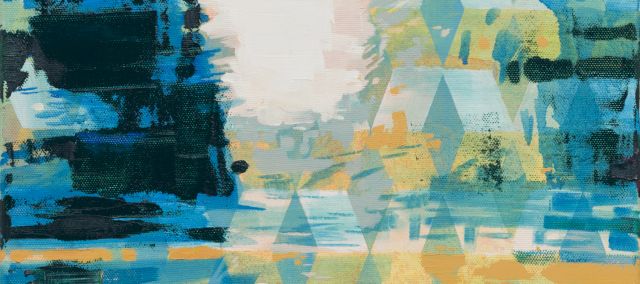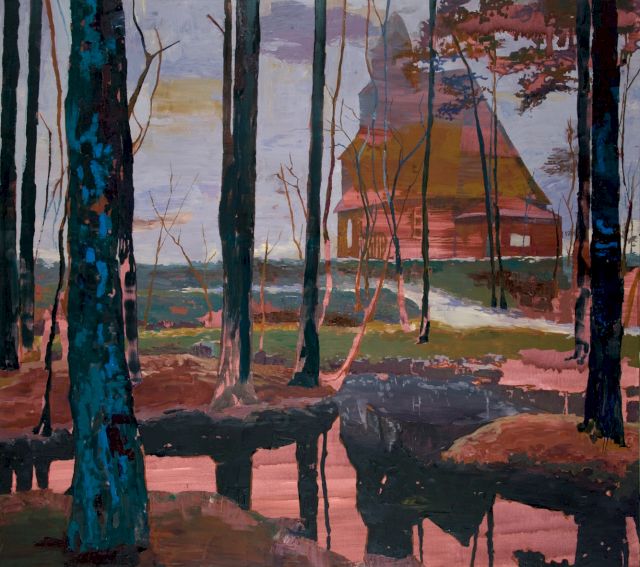Independent Collectors
Manfred Herrmann
The Berlin based tax consultant Manfred Herrmann and his wife art historian Burglind-Christin Schulze-Herrmann have been collecting contemporary art for the last 30 years.

During that time the two have made many artist friends along the way, with one of them being Berlin based artist Michelle Jezierski, whose work the Herrmann’s have been collecting since 2008.
IC visited Michelle Jezierski and Manfred Herrmann in his office to talk about artists, collectors and their own artist-collector relationship.
Mr. Herrmann, did you collect anything else before you started collecting art?
MH: I have always been interested in art since my youth and started collecting in the 1980s, which is also the time I met my wife, who studied art history and has a very good eye for contemporary works. Back in the day she was part of an artist collective where she met a lot of young and emerging artists of the time and it was around then that I started to buy my first pieces of contemporary art. The collection has grown continuously ever since.
And when did you first meet Michelle?
MH: Oh it must be around five or six years ago, right?
MJ: Yes, at least. I graduated from the University of the Arts Berlin in 2008 and in that year I had my exhibition “Augenweiden” at the exhibition space of Vattenfall in Berlin.
MH: Right! So we met eight years ago through the gallerist Klara Wallner. She used to have a space on Brunnenstraße that featured a lot of young artists.
MJ: When I met Manfred I told him about the upcoming Vattenfall exhibition and invited him and his wife Burglind, “Burgi”, to come and see it.
MH: It was an invitation we happily accepted. I remember, we saw the exhibition and right away decided to buy a few works from Michelle.
MJ: Yes, I recall you bought “Race Track” – a work, which hangs here in your office, and a painting called “Wolkenwust”.
MH: And a piece called “Blaze”. We bought these three works of Michelle quite spontaneously because they captivated us instantly.
What fascinates you about Michelle’s work in particular?
MH: It’s hard to describe. It is very much about her use of imagery and her very own pictorial language. I particularly enjoy how she merges the abstract and the concrete in her works, and of course I am fascinated by her use of color. There is something very joyful about the colors she uses, which are often juxtaposed with a subject matter that depicts something mysterious or sinister even.


Have you ever commissioned a work from Michelle?
MH: No, we have never commissioned a work. We do however have a piece by Michelle, which might as well have been a commission.
MJ: I know the piece you are talking about! There is one painting called “Silver Salts”, which I had been working on when you both came to visit me in my studio. Right away Burgi, said intuitively she wanted to buy it. I was surprised since the work wasn’t even finished yet and had never been exhibited nor ever left the studio.
When I visited Manfred and Burgi at home a little while later and saw where they placed it, I understood why she bought it at once. The color of the wall it was hanging at corresponded in perfect harmony to the painting. It was almost a little uncanny.
You seem to have built a very close artist and collector relationship…
MH: Yes. We do see each other on a regular basis; we attend each other’s birthday parties for example. There is definitely a friendship that evolved since our first encounter in 2008.
MJ: I very much enjoy that we meet up from time to time at events, birthdays or when you come to visit me in my studio about once or twice a year. We never really lose touch, which is a nice thing to say.
Is it important for you to meet the artist whose works you buy?
MH: No. It just developed naturally. When I first started collecting I did not actively look for art to buy. I did not even have a fixed idea of what I wanted to include in my collection to start with. Instead I bought works from artists I encountered personally. That’s the kind of context which we started to build the collection. By now we have collected about 560 works and, of course, it includes artists who we have never met before. Next to Berlin based or German artists like Daniel Richter, Jonathan Meese, John Bock and Anselm Reyle the collection also includes many international artists such as Ai Wei Wei, Peter Doig, Damien Hirst, Sarah Morris and Jaume Plensa.
I have spoken with some collectors who actually prefer to not meet the artist. Some say that a personal encounter actually hinders them to see the work in an objective way or that they fear that their way of collecting would become too emotional. For me personally, it does make it more interesting to get to know the artist, but I never considered it a requirement to buy a work.
What’s definitely enjoyable about keeping a personal relationship with the artist is that you get to witness their artistic development from a perspective that is not too distant. Of course it can happen that as a collector you lose interest in an artist’s work as their career proceeds for various reasons, but mostly it is an interesting experience to follow the development of an artist who you have been collecting from an early on.
How do you live with art? Do you install everything in your office or at home or do you keep a lot of works in storage, too?
MH: A little bit of everything. Most of the works are installed either in the office or at home. Some of them we don’t get to see every day because they are on loan to different museums or in storage because we don’t have enough space or they are just simply too big.
I always like to hang and look at the works we bought recently, the ones that add something fresh because I didn’t get use to looking at them yet.
The German artist Birgit Brenner once said in an interview with IC that it is interesting for her to think about how collectors live with her work at home for years when the time she spent planning and creating them is considerably shorter. Do you feel the same way, Michelle?
MJ: It’s true – that it is an interesting thought. I do like the fact that my pieces are spread in different collector’s homes. I think I would go insane if my finished works would take up too much space in my studio. When my work leaves the studio, I consider the time I spent with them complete. Instead, I prefer to start working on the next blank canvas and create something new. Of course there are pieces that are very dear to me, works that I consider key pieces and that I would like to look at again from time to time.
How does it feel when you see older works of yours at Manfred and Burglind’s house? Do you enjoy looking back at past work?
MJ: Yes, sometimes I do look at an older work of mine, however I can never really stop the thought process that then starts to spin off in my head. I start seeing things that I have already experimented with back then and compare it to what I am doing now. Sometimes it is interesting to see the start of something technical or compositional that later ends up becoming a bigger part of my work, something I have continually investigated and developed further. Occasionally I also think I would do certain things differently now.
So it’s definitely a nice and stimulating thing to be able to revisit what you have done but at the same time I am not too fussed about it. What’s important to me is that I have a photograph taken of the pieces I’ve done for my archive. Afterwards I want the works to take up a life of their own outside the studio.
Is it important to you that you know the person who buys your work?
MJ: I always find it fascinating to observe which collector picks which work. Often I am curious about finding out certain aspects about the collector’s personality: what kind of person is the collector? What is he or she interested in? What do they see when looking at my works? What do they think is interesting about them? It’s a fascinating dialogue because a work of art is rarely perceived and looked at in the same way. What is interesting? And what is there to see? Those are questions that I regularly ask myself when painting in isolation in my studio. So it is thought provoking to revisit those questions later on in a dialogue with someone who has never encountered the work before.
Sometimes a dialogue can form the foundation for a closer artist-collector relationship, which is something I enjoy, and sometimes it doesn’t, which is completely fine, too.
MH: Do you sometimes have an idea of what a specific collector who visits your studio might like in particular and display your works accordingly?
MJ: No, I don’t think about it in advance. Maybe I should be more strategic (laughs). What I like to do is to show what I have recently been working on. So when people visit my studio, I always display what I have just done or what I am currently working on, simply because it’s the work I would like to talk about the most at that time.
And are you interested in knowing where and how your work will be placed and shown?
MJ: Yes, that I am curious about. Mostly because it can be a very rewarding experience to see the work in a new context, especially when something works really well such as in the case of the aforementioned work “Silver Salts” in Manfred’s and Burgi’s home. I am often surprised how well the work and its new surroundings work together and how the context of a private home can add a different dimension to the perception of a piece in comparison to an artist’s studio or a white-cube gallery.
Of course there have also been a very few times where I actually disliked the way the work was presented or placed in a collector’s home. But it is not my place to say this ¬– unless someone asks me directly.